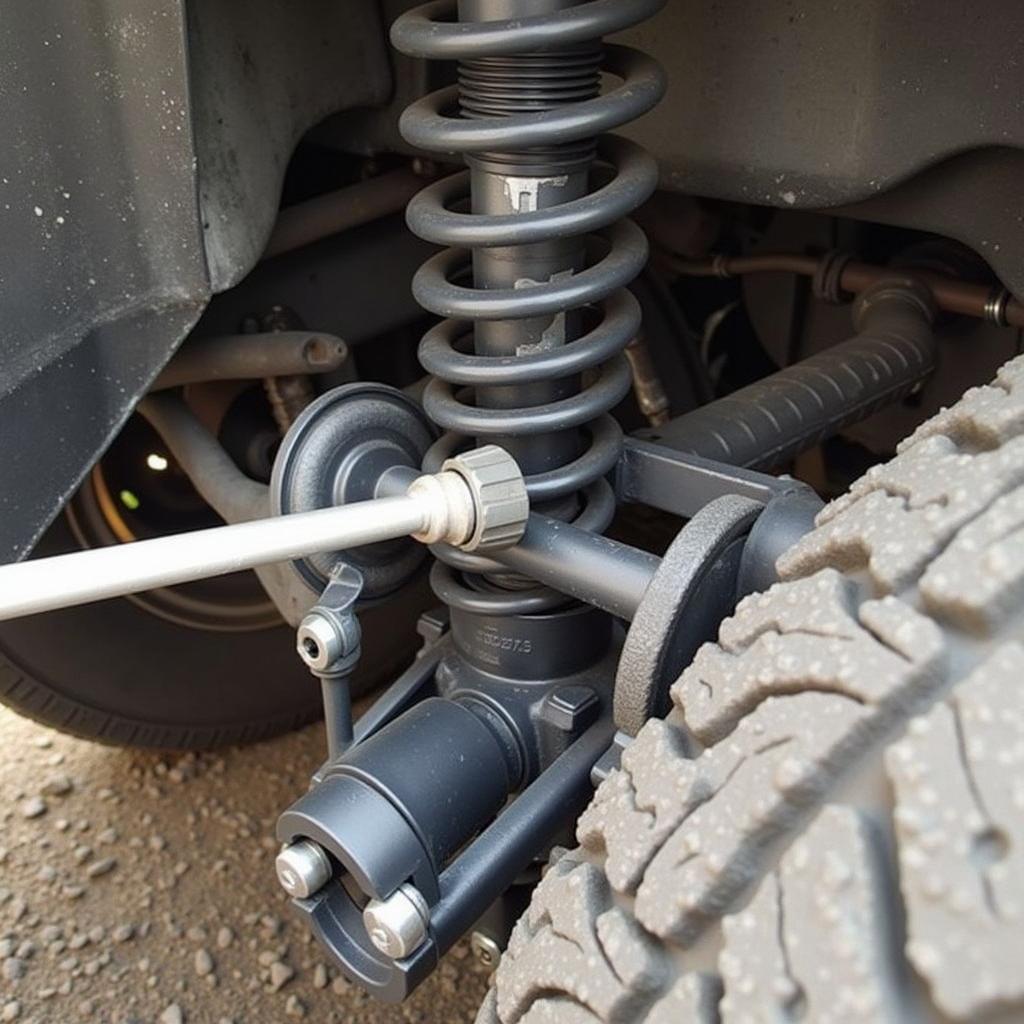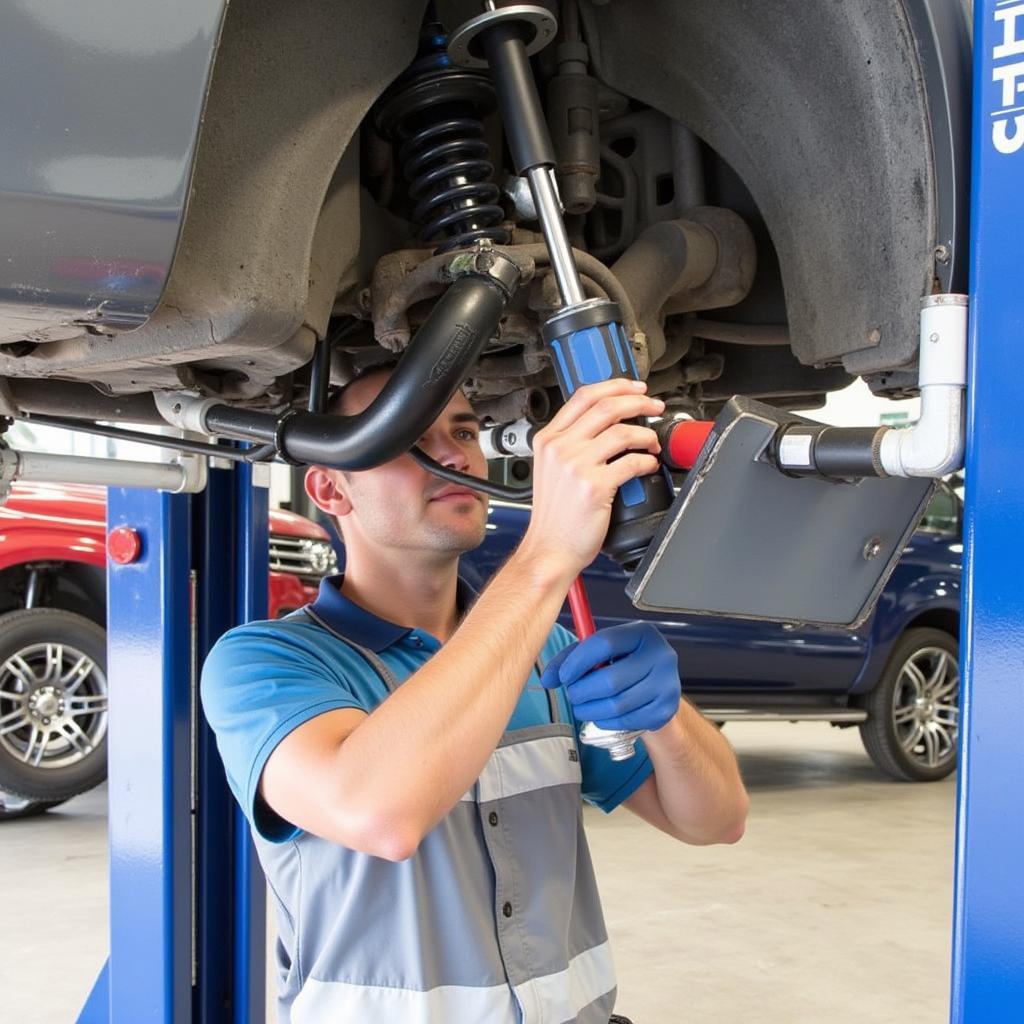That annoying clunking noise coming from your car’s suspension? It’s not just irritating; it could be a sign of a serious problem. This guide will help you diagnose and potentially fix that car suspension clunking noise, whether you’re a seasoned mechanic or a concerned car owner.
Addressing suspension issues early can save you money and headaches down the road. We’ll cover everything from simple checks you can do yourself to more complex repairs that may require a professional touch. So, let’s dive in and silence that clunk!
Common Causes of Clunking Noises in Car Suspensions
Clunking noises can stem from various components within your suspension system. Identifying the source is crucial for effective repair. Here are some of the most common culprits:
- Worn-out Struts or Shock Absorbers: These components absorb impacts and keep your tires in contact with the road. Worn-out struts or shocks can lead to excessive bouncing and clunking, especially over bumps.
- Loose or Damaged Sway Bar Links/Bushings: Sway bars control body roll during turns. Worn or loose links and bushings can create a clunking or rattling noise, especially when cornering.
- Worn Control Arm Bushings: Control arms connect the wheels to the chassis. Deteriorated bushings allow excessive movement, resulting in a clunking sound.
- Ball Joint Issues: Ball joints allow the wheels to move up and down and steer. Worn or damaged ball joints can cause a clunking or popping noise, especially when turning or going over bumps.
- Tie Rod End Problems: Tie rod ends connect the steering rack to the wheels. Worn tie rod ends can create a clunking noise during turning.
- Broken Coil Springs: Coil springs support the weight of the vehicle. A broken spring can cause a loud clunking or banging noise.
Diagnosing the Clunking Noise
Pinpointing the exact source of the clunking noise requires a systematic approach. Here’s a step-by-step guide:
- Listen carefully: Pay attention to when the noise occurs (e.g., over bumps, during turns, or when braking). This will help narrow down the possibilities.
- Inspect visually: Check for any obvious signs of damage, such as broken components, leaks, or excessive wear and tear.
- The “Bounce Test”: Push down on each corner of your car and release. Excessive bouncing or a clunking noise indicates worn struts or shocks.
- Check for play: Inspect the sway bar links, control arm bushings, ball joints, and tie rod ends for excessive movement or play.
 Checking Suspension Components for Play
Checking Suspension Components for Play
Having trouble with some minor paint chips? Check out how to fix a small paint chip on my car.
DIY Fixes vs. Professional Repairs
Some suspension repairs can be tackled by DIY enthusiasts, while others require specialized tools and expertise. Replacing sway bar links or bushings, for example, is often a manageable DIY project. However, replacing ball joints or struts usually requires professional help.
Remember, safety is paramount. If you’re unsure about any repair, it’s always best to consult a qualified mechanic.
Preventing Future Clunking Noises
Regular maintenance is key to preventing suspension problems. Here are some tips:
- Regular inspections: Inspect your suspension system regularly for signs of wear and tear.
- Proper lubrication: Keep all moving parts properly lubricated.
- Careful driving: Avoid potholes and rough roads whenever possible.
 Regular Car Suspension Inspection
Regular Car Suspension Inspection
Need to fix paint chips on my car? Here’s a helpful guide. You can also find affordable solutions on how to fix my car paint chips cheap.
Conclusion
A clunking car suspension noise isn’t something to ignore. By understanding the common causes and following the diagnostic steps outlined in this guide, you can address the issue effectively and keep your car running smoothly. Remember, regular maintenance and prompt repairs can save you money and ensure a safe and comfortable ride.
If you need assistance or have further questions, please don’t hesitate to contact us at AutoTipPro. Our expert team is here to help. You can reach us at +1 (641) 206-8880 or visit our office at 500 N St Mary’s St, San Antonio, TX 78205, United States.
Looking for advice on how to fix a paint chip on your car? We’ve got you covered! Or perhaps you’re wondering how can I fix paint chips on my car? Check out our comprehensive guide.
FAQ
- How much does it cost to fix a clunking suspension? The cost varies depending on the specific problem and the make and model of your car.
- Can I drive with a clunking suspension? While you might be able to drive, it’s not recommended. A clunking noise can indicate a serious safety issue.
- Is a clunking noise always a suspension problem? Not necessarily. Other issues, such as loose exhaust components, can also cause clunking noises.
- How often should I inspect my suspension? It’s a good idea to have your suspension inspected at least once a year or every 12,000 miles.
- What tools do I need to diagnose a suspension clunking noise? Basic tools like a jack, jack stands, and a pry bar can be helpful.
- Can I fix a broken coil spring myself? Replacing coil springs is generally best left to professionals due to the potential dangers involved.
- How can I prevent suspension damage? Avoid potholes, drive carefully over rough terrain, and maintain proper tire pressure.




Leave a Reply